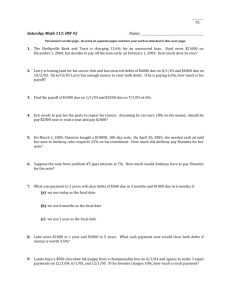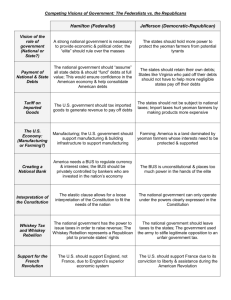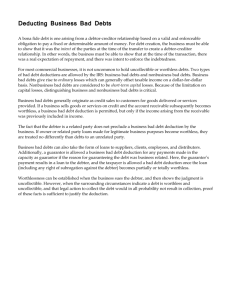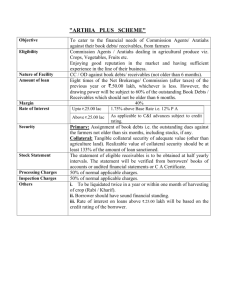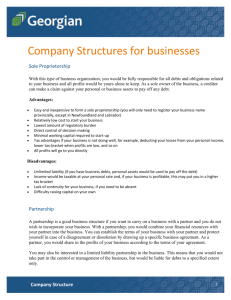determinants of corporate debts: the case of oil & gas and textile
advertisement
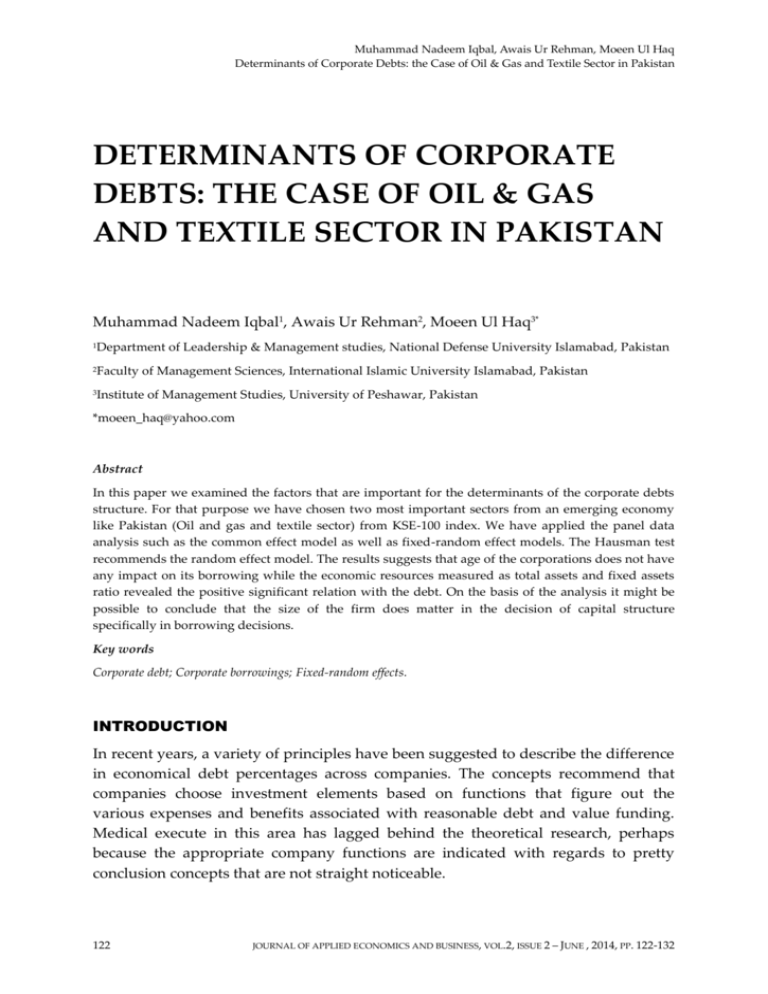
Muhammad Nadeem Iqbal, Awais Ur Rehman, Moeen Ul Haq Determinants of Corporate Debts: the Case of Oil & Gas and Textile Sector in Pakistan DETERMINANTS OF CORPORATE DEBTS: THE CASE OF OIL & GAS AND TEXTILE SECTOR IN PAKISTAN Muhammad Nadeem Iqbal1, Awais Ur Rehman2, Moeen Ul Haq3* Department of Leadership & Management studies, National Defense University Islamabad, Pakistan 1 Faculty of Management Sciences, International Islamic University Islamabad, Pakistan 2 Institute of Management Studies, University of Peshawar, Pakistan 3 *moeen_haq@yahoo.com Abstract In this paper we examined the factors that are important for the determinants of the corporate debts structure. For that purpose we have chosen two most important sectors from an emerging economy like Pakistan (Oil and gas and textile sector) from KSE-100 index. We have applied the panel data analysis such as the common effect model as well as fixed-random effect models. The Hausman test recommends the random effect model. The results suggests that age of the corporations does not have any impact on its borrowing while the economic resources measured as total assets and fixed assets ratio revealed the positive significant relation with the debt. On the basis of the analysis it might be possible to conclude that the size of the firm does matter in the decision of capital structure specifically in borrowing decisions. Key words Corporate debt; Corporate borrowings; Fixed-random effects. INTRODUCTION In recent years, a variety of principles have been suggested to describe the difference in economical debt percentages across companies. The concepts recommend that companies choose investment elements based on functions that figure out the various expenses and benefits associated with reasonable debt and value funding. Medical execute in this area has lagged behind the theoretical research, perhaps because the appropriate company functions are indicated with regards to pretty conclusion concepts that are not straight noticeable. 122 JOURNAL OF APPLIED ECONOMICS AND BUSINESS, VOL.2, ISSUE 2 – JUNE , 2014, PP. 122-132 Journal of Applied Economics and Business The primary strategy taken in past scientific execute has been to figure out regression equations with proxies serves hosts for the unobservable theoretical functions. This strategy has a variety of issues. First, there may be no unique advice of the functions we wish to figure out. There are often many possible proxies’ serves for a particular operate, and scientists, losing theoretical recommendations, may be ready to choose those aspects that execute best concerning mathematical goodnessof-fit requirements, thereby biasing their show of the importance levels of their assessments. Second, it is often hard to find activities of particular functions that are irrelevant to other functions that are of interest. Thus, selected proxies serves aspects may be identifying the repercussions of several different functions. Third, since the noticed aspects are partly representations of the functions they are required to figure out, their use in regression research provides an errors-in-variable issue. Lastly, figure faults in the proxy’s factors may be associated with figure faults in the dependent factors, developing unnecessary relationships even when the unobserved function being measured is unrelated to the dependent different. Hundreds of documents examine corporate economical choices and the aspects that effect investment framework. Much theoretical perform characterizes the choice between economical debt and value in a trade-off perspective in which companies choose their maximum economical debt rate by controlling the advantages and expenditures. Typically, tax savings that occur because attention is insurance deductible have been patterned as a primary benefit of economical debt (Kraus & Litzenberger, 1973). Other advantages consist of spending professionals to operate efficiently (Jensen, 1986) and interesting lenders to observe the company (Jensen & Meckling, 1976). The expenses of reasonable debts contain reasonable stress (Scott, 1976), personal taxes (Miller, 1977), reasonable debts overhang (Myers, 1977), and organization arguments between experts and investors or among different categories of investors. For the most part, these theoretical predictions have been examined using decreased form regressions that make an effort to explain change in investment structure guidelines based on calculated hill coefficients for factors such as company size, tax position, source tangibility, success, and development options (Rajan & Zingales, 1995; Frank & Goyal, 2009; Graham et al, 1998). Most theoretical models of debts source choice assume financial institution and personal nonbank debts are equivalent, and most previous empirical studies either exclude financial institution debts or combine it with personal non-bank debts. There are two exceptions to this in the empirical literature. Hooks and Opler (1993) considers financial institution debts separately, but studies relatively small firms that likely cannot borrow in public debts markets. 123 Muhammad Nadeem Iqbal, Awais Ur Rehman, Moeen Ul Haq Determinants of Corporate Debts: the Case of Oil & Gas and Textile Sector in Pakistan Carey, et al. (1993) consider larger firms and finds differences between financial institution and personal non-bank debts, but uses short-term debts to proxy financial institution debts, and long-term non-public debts to proxy personal non-bank d09ebts. Their choice of proxies risks confounding maturity and debts ownership effects. In contrast, Fama (1985) and Nakamura (1993) argue there are important differences between the sources. The purpose of this research paper is to find out the factors that influences the corporate debts structure in the context of Pakistan. This paper examines the most important factors namely fixed assets ratio, leverage, long term assets, age, market to book ratio and long term debts are examines. The sample of 33 companies was taken with the time span of 9 years from 2002 to 2010. This research explores the factors of corporate borrowing that can help them for corporate borrowing structure for future decision makings. LITERATURE REVIEW Researchers face several concerns when they examine how tax benefits impact company reasonable policy and company value. Major among these concerns is the problems of identifying company tax prices due to data concerns and the complexness of the tax value. Other issues include quantifying the repercussions of attention taxation at the person level and understanding the person bankruptcy process and the personnel expenses of reasonable stress. In this document we mainly focus on identifying company tax benefits. We create a new evaluate of the tax benefits of reasonable debt that provides information about not just the slight tax amount but the entire tax benefit work. A company's tax operate is defined by a series of minor tax prices, with each amount corresponding to a specific stage of attention reductions. Each minor tax amount features the consequences of non-debt tax safety measures, tax-loss bring backs, bring ahead, tax breaks, the alternative minimum tax, and the possibility that attention tax safety measures will be used in a given year, based on the technique of Graham (1996). In a related paper, Welch, and Zhu (1996) study the mix of community and private debts companies use. Although they focus on potential holdup problems created by credit from a single financial institution. Rajan (1992) also predicts the preference often bank debts related to a borrower's bargaining power with loan companies. He indicates scientific proxy servers for negotiating power might be the level of control loan companies have over a customer's providers or the level of the lender's value possession of the client, either of which are openly available. We could not think of an effective alternative evaluate so we do not analyze the effects of this feature. In Hoshi et al. (1993), the loan companies observe firm professionals to prevent unprofitable financial commitment. Managers of companies with successful financial commitment possibilities find committing in unprofitable pet tasks more costly; 124 JOURNAL OF APPLIED ECONOMICS AND BUSINESS, VOL.2, ISSUE 2 – JUNE , 2014, PP. 122-132 Journal of Applied Economics and Business thus, they do not need to be supervised and prefer community debts. Recognizing unprofitable pet tasks are more affordable for professionals of companies with unappealing financial commitment possibilities, so they require financial institution tracking to pay properly. One conclusion from these traditional records is that there must be other reasonably large expenses of reasonable debts to justify the reasonable debts alternatives that companies create. While these traditional records are helpful, our analysis contributes by directly determining ex wage all-in expenses of reasonable debts, and by assessing a broad cross-section of companies rather than a little ex post taste. Recent research claims that thorough consideration leads to expenses of reasonable debts that approximately equivalent the slight (tax) benefits of reasonable debts in stability. For example, in Green and Hollifield’s (2003) model, personal bankruptcy expenses similar to 3% of organization value, combined with a personal tax disadvantage to attention income, are sufficient to justify an interior optimal reasonable debts rate. Berk et al. (2010) determine that higher wages due to enhanced manual work risk associated with greater company create use of should be designed as a cost of reasonable debts. Carlson and Lazrak (2006) argument that enhanced organization risk due to resource alternative produces expenses sufficient to balance out the tax benefits of reasonable debts. Our approach records these and other expenses of reasonable debts that drive observed (equilibrium) company reasonable debts alternatives. The resulting cost challenge is a positive operate of the stage of reasonable debts and its location is depending on organization features related to the theorized factors. DATA AND METHODOLOGY For the empirically assessment of research, we take 33 organizations from the Oil, Gas & Power sector and Textile sector. For assessment, we have taken the information from the Balance Sheet Analysis (BSA) that is released annually by Stat Bank of Pakistan. The penal information is designed by taking the information on annually base from 2002 to 20010 with the complete period of 9 years of the 33 organizations, in which cross sectional information is organizations and time series factors are years. Six factors are taken namely Fixed Assets Ratio (FAR), Long Term Debt (LTD), Market to Book Ratio (MTBR), Total Assets (TA) and Age of the organization. We have taken the log of the long term debts and total assets. These factors are measured for each organization for each season. Then the descriptive statistics is used to check the normality of the information (Table 1). Then the regression method is applied by placing long term debt as a dependent variable and all other variables i.e. Fixed 125 Muhammad Nadeem Iqbal, Awais Ur Rehman, Moeen Ul Haq Determinants of Corporate Debts: the Case of Oil & Gas and Textile Sector in Pakistan assets ratio, market to book ratio, total assets and age as independent variable. The following regression model is used: 𝑦𝑖 = 𝛽0 + 𝛽1 𝑥1 +∙∙∙∙∙∙∙∙∙∙ 𝛽𝑛 𝑥𝑛 + 𝜀𝑛 (𝑖) (1) Long term debts and total assets are in million rupees, market to book ratio is calculated by minus the total assets from book value of equity plus market value of equity dividing total assets. Leverage is measured by dividing long term debts and total assets. Fixed assets divided by total assets are fixed asset ratio. Age is the period of time after the season of founded. In this document we also analyze the Heteroskedasticity and discovered very powerful proof of it. According to Guajarati (1999) if the Heteroskedasticity was discovered then use the Robust Slandered Error system for the treatment of this issue. Then we used the Fixed Effect Model and Random Effect Model. The following fixed effect and random effect model is used. yit = β1 xit + αi + μit Yit = β0 + β1 X1,it +∙∙∙ + βk Xk,it + y2 E2 +∙∙∙∙ + yn En μit . (2) (3) Here equation (2) and equation (3) are modeled as the fixed and random effect where: • αi (i=1….n) is the unknown intercept for each entity (n entity-specific intercepts). • Yit is the dependent variable (DV) where i = entity and t = time. • Xit represents one independent variable (IV), • En is the entity n. Since they are binary (dummies) you have n-1 entities included in the model. • γ2 Is the coefficient for the binary repressors (entities) • β1 is the coefficient for that (IV), • 𝜇𝑖𝑡 is the error term Hausman test is used to decide whether which model is best between fixed and random effect models. Where, the null hypothesis is that the random effect model is best or preferred. Basically, Hausman test check the unique error (𝜇𝑖 ) is correlated with the regressor or not, if or not then its means our alternative hypothesis is accepted that is fixed model is best. EMPIRICAL RESULTS The descriptive statistic test describes the normality of the data. If we see Table 1, the skewness of all the variables are positive except the variable long term debts, which point out that large negative returns equal to minimum extreme value are large then the higher positive returns i.e. maximum extreme value and the Skewness of the long term debts. 126 JOURNAL OF APPLIED ECONOMICS AND BUSINESS, VOL.2, ISSUE 2 – JUNE , 2014, PP. 122-132 Journal of Applied Economics and Business Mean Median Maximum Minimum Std. Dev. Skewness Kurtosis LEV 0.2652 0.1804 2.6970 0.0000 0.2945 2.8236 19.5634 TABLE 1. DESCRIPTIVE STATISTICS FAR AGE LTA 0.9677 25.8636 7.6667 0.9447 18.0000 6.9194 2.1280 96.0000 34.0000 0.0000 1.00000 2.6810 0.3284 18.8141 2.5570 0.4185 1.60339 4.2466 4.3910 5.69486 43.7636 LTD 5.1419 5.4295 10.0839 -0.6931 2.6565 -0.4081 2.6745 MTB 0.8130 0.7253 3.9957 0.0314 0.4859 3.1564 17.4319 Kurtosis is positive for the all the variables which indicates that the companies are leptokurtic distributed indicating higher peaks then expected from normal distribution. Then the correlation test was used to test our hypothesis. As our first hypothesis states that there is a positive association that links leverage and fixed asset ratio. Therefore to judge the association between these two constructs correlation was used. Correlation tells us about the relationship either it is positive, negative or if there is no relationship (Table 2). TABLE 2. CORRELATION MATRIX LEV FAR AGE LTA LTD MTB LEV FAR AGE LTA LTD MTB 1.0000 0.4223 -0.1490 -0.1723 0.3876 0.5944 1.0000 -0.0580 -0.2224 0.1155 0.4068 1.0000 0.2627 0.0441 0.0125 1.0000 0.3910 -0.2831 1.0000 0.0171 1.0000 The Correlation between fixed asset ratio and leverage is 0.422 which is positive and significant. In other words we can say that there is moderating relationship between fixed asset and leverage. Moreover it is also indicated by correlation results that these are significant at a level of 0.01. Leverage has negative and weak relationship with age and long term assets and relationship with long term debts and market to book ratio is positive moderating. Fixed assets ratio has a negative and weak relation with age and long term assets and positive moderating relationship with market to book ratio. Age has a positive and weak relationship with long term assets, long term debts and market to book ratio. While the relation of long term assets with long term debts are positive and moderating and relationship with market to book ratio is weak negative. Long term debts have positive and weak relationship with market to book ratio. After detailed description of the data now, for the purpose of analysis we firstly apply the ordinary least square regression followed by heteroskadasticity test. Than we further apply the fixed and random effect models to our data. As these models 127 Muhammad Nadeem Iqbal, Awais Ur Rehman, Moeen Ul Haq Determinants of Corporate Debts: the Case of Oil & Gas and Textile Sector in Pakistan are recommended when there are variables which vary over time. The fixed effect model is useful when someone want to explore the relationship between predictor and outcome variables within and entity; it might be a country or company. We also applied the random effect model in our analysis; the rationale behind using this model was that the variations across cross sections are assumed to be random and uncorrelated with the independent variables, as this was not in case of fixed effect model. Finally, we apply the Hausman test to decide between fixed and random effect. The null hypothesis states that the co-efficient of the random effect models are consistent while the alternate hypothesis says the fixed effect model is good. TABLE 3. ORDINARY LEAST SQUARE REGRESSION Long Term Debts Coefficient Age 0.0031501 Fixed Asset ratio 0.5129353 Leverage 5.179025 Long Term Assets 0.4508085 Market to Book ratio -1.243117 Constant 0.7446759 F(5, 258) = 33.92, Prob>F = 0.0000, R squared = 0.3967, Adj. R-squared = 0.3850 t-Value 0.43 1.15 9.07 8.19 -3.55 1.13 After the correlation test we applied the regression test (Table 3) by putting the long term debt as dependent variable and all other variable as independent variables. The result shows that the coefficient of the age and fixed asset ratio is 0.003150 and 0.512935 respectively, and t-stat of both shows positive insignificant relation with the long term debts. Its mean corporate debts structure has no impact of age and fixed assets ratios. It also proves the significant and positive relationship with the leverage and long term assets. As the coefficient of the leverage and long term assets is 5.17 and 0.44 respectively. But relationship with the market to book ratio is significant with the negative sign. Its means that leverage and long term debts have impact on the corporate debts structure in a positive sense and negative impact of the market to book ratio on long term debts. If we see the R-square its give use the value of 0.3966 its means the variation of the dependent variable around its mean is just 39.66% which is not good enough. HETEROSKEDASTICITY TEST Breusch-Pagan / Cook-Weisberg test for Heteroskedasticity Chi2 (1) = 162.49 Prob > chi2 = 0.0000 Ho: Constant Variance Variables: Fitted values of long term debts By moving forward we test the data for heteroskedasticity and found evidence of heteroskedasticity in the data as the probability is less than 0.05 it is (0.0000) which signifies that there is heteroskedasticity in the data. We test the heteroskedasticity in our data and found the strong evidence of it (see table 04). The value of probability is less than 0.5 then its mean that significant heteroskedasticityis present in the data. 128 JOURNAL OF APPLIED ECONOMICS AND BUSINESS, VOL.2, ISSUE 2 – JUNE , 2014, PP. 122-132 Journal of Applied Economics and Business According to Gujarati (1999) if in our data the problem of heteroskedasticity is available then use the robust standard error method to avoid that problem. After that we applied the fixed effect model. Table 5 reports the results of the fixed effect model, similar to the ordinary least square results here. The F-statistics lies between its significance level as it shows that the co-efficient differs significantly from zero, and the overall R2 like between and within does confirm the goodness of fit of the model. When we test the fixed effect model it shows that there is insignificant and negative relationship between long term debts and age with the coefficient value -0.06199. Coefficient of fixed asset ratio is -0.7539 with t-stat value of -1.65 which is negative and insignificant. Leverage and long term asset have positive and significant relationship with dependent variable long term debts with the coefficient value of 4.70 and 0.129 respectively with t-stat value of 2.23 and 1.99 which shows significant impact on the corporate debts. Market to book ratio has positive but insignificant relationship with long term debts. Age factor has no impact on the corporate borrowing but leverage and long term assets have positive impact. Long Term Debts Age Fixed Asset ratio Leverage Long Term Assets Market to Book ratio Constant Rsq: within = 0.2381 between = 0.0685 overall = 0.1032 TABLE 5. FIXED EFFECT MODEL Coefficient Robust Stq. Error -0.0619973 0.0454097 -0.7539181 0.4598461 4.704668 2.106381 0.1290081 0.0649097 0.0773178 0.4117673 5.175041 1.396324 F(5,226) = 3.77 Prob > F = 0.0027 t-Value -1.37 -1.64 2.23 1.99 0.19 3.71 The value of R-squared is 0.6841 its means that variation of the dependent variable around its mean is just 68.41% which is quite significant. Long Term Debts Age Fixed Asset ratio Leverage Long Term Assets Market to Book ratio Constant R-sq: within = 0.2100 between = 0.4881 overall = 0.3525 TABLE 6. RANDOM EFFECT MODE Coefficient Robust Stq. Error 0.0045068 0.0193568 -0.3912481 0.544304 4.841856 1.648516 0.2403326 0.149663 -0.6550792 0.3748799 2.809613 1.439427 Wald chi2(6) = 617.88 Prob > chi2 = 0.0000 t-Value 0.23 -0.72 2.94 1.61 -1.75 1.95 Table 6 describes the random effect model. This model shows that the coefficient of age is 0.0045 with the z-stat 0.23 which means that variable age is positively 129 Muhammad Nadeem Iqbal, Awais Ur Rehman, Moeen Ul Haq Determinants of Corporate Debts: the Case of Oil & Gas and Textile Sector in Pakistan insignificant with the dependent variable long term debts. Fixed asset ratio coefficient is -0.3912 with z-stat -0.72 which is also insignificant with negative values. Leverage is positively significant with the long term debts as the z-stat value is 2.94 with the coefficient value of 4.8418. The coefficient values of long term assets and market to book ratio is 0.2403 and -0.6550 with the z-stat values of 1.61 and -1.75 which indicates that both the independent variable has insignificant relationship with dependent variable 5% level of significance but at 1% level of significance both are significantly related to the dependent variable with positive and negative signs. TABLE 7. HAUSMAN TEST Coefficient Difference (b) fe (B) re ((b-B) Age -0.619973 0.0045068 -0.0665041 Fixed Asset ratio -0.7539181 -0.3912481 -0.3626699 Leverage 4.704668 4.841856 -0.1371887 Long Term Assets 0.1290081 0.2403326 -0.1112345 Market to Book ratio 0.0773178 -0.6550792 0.732397 Test: Ho: Difference in coefficients not systematic Chi2(5) = (b-B) ‘ [(V_b-V_B)^(-1)] (b-B) Chi2 (5) = 3.15 Prob>chi2 = 0.6773 (V_b-V_B is not positive definite) Sqrt (diag(V_b-V_B)) S.E> 0.410774 0.0000 1.311197 0.0000 0.1703447 Finally, Table 7 presents the results of the Hausman test. As known, the Hausman test tells us the choice of the fixed and random effect models. As in our data the Hausman test reports that the random effect model is better than fixed effect model because the p-value > 0.05 as shown in table-6 it is (0.6773). The Hausman test basically tells us whether the unique errors (ui) are correlated with the regressors, the null hypothesis is they are not. In the analysis, the Hausman test reports that the random effect models provide consistent and efficient estimates. CONCLUSION This paper examines the factors that determined the corporate debts structure. Primarily our focus was on investigating different types of firm’s indicators like profitability, size, age, fixed assets ratio and market to book ratio that may affect and force the corporations to borrow. For that purpose we have selected the two most important sectors of Pakistan i.e. oil, and gas and textile. In this empirical study, we have used the panel data analysis like fixed effect model and random effect model. The findings of the study reveals that fixed assets ratio shows the negative impact on debt while on the other hand total assets shows the positive impact. Leverage also shows the positive relationship with the debt whereas market to book ratio shows negative relationship with the corporate borrowings. Age of the corporations does not showed any kind of statistically significant relationship with the debt. Hence, it might be possible to conclude on the basis of our empirical findings that the firms which have higher fixed assets ratios uses less debts and rely only on their own 130 JOURNAL OF APPLIED ECONOMICS AND BUSINESS, VOL.2, ISSUE 2 – JUNE , 2014, PP. 122-132 Journal of Applied Economics and Business resources. The total assets of the firms does affect the corporate borrowings, however there may be possibility that the corporations included so many other type of assets other than fixed. In addition, these assets only represent and fulfill the liquidity requirements of the organizations. If we observe the leverage it obviously shows the positive relationship while higher market to book ratios leads towards lower borrowings. In the analysis, we found that the number of years of corporations since its inception does not affect the decisions of borrowing. One can conclude that the age of the firm is not an indicator of corporate borrowings. The other indicators described earlier may also be taken as the determinants of corporate debt in Pakistan. The macroeconomic conditions in Pakistan are highly volatile, and these conditions have major influence on the financial as well as manufacturing and industrial sectors of the country. REFERENCES Berk, J., Stanton, R. & Zechner, J. (2010). Human Capital, Bankruptcy and Capital Structure, Journal of Finance, 65(3), 891-926. Bris, A., Welch, I. & Zhu, N. (2006). The Costs of Bankruptcy: Chapter 7 Liquidation versus Chapter 11 Reorganization, Journal of Finance, 61, 1253-1303. Carlson, M. & Lazrak, A. (2006). Leverage Choice and Credit Spread Dynamics When Managers Risk Shift, Working paper, Sauder School of Business, UBC. Carey, M., Prowse, S., Rea, J. & Udell, G. (1994). Economics of the Private Placement Market, Federal Reserve Bulletin, 80, 5. Fama, E. (1985). What's Different about Banks?, Journal of Monetary Economics, 15, 29-37. Frank, M. Z. & Goyal, V. K. (2009). Capital Structure Decisions: Which Factors are Reliably Important?, Financial Management, 38, 1-37. Graham, J. R., Lemmon, M. L. & Schallheim, J. S. (1998). Debt, Leases, Taxes, and the Endogeneity of Corporate Tax Status, Journal of Finance 53, 131-162. Green, R. C. Burton, H. (2003). The Personal-Tax Advantages of Equity, Journal of Financial Economics, 67, 175-216. Graham, J. R. (1996). Debt and the marginal tax rate, Journal of Financial Economics 41, 41–73. Gujarati, D. (1999). Essentials of Econometrics, 2nd ed., McGraw-Hill, New York. Hooks, L. & Opler, T. (1993). The Determinants of Corporate Bank Borrowing, Federal Reserve Bank of Dallas Financial Industry Studies, 1-21. 131 Muhammad Nadeem Iqbal, Awais Ur Rehman, Moeen Ul Haq Determinants of Corporate Debts: the Case of Oil & Gas and Textile Sector in Pakistan Hoshi, T., Kashyap, A. & Scharfstein, D. (1993). The Choice between Public and Private Debt: An Analysis of Post-Deregulation Corporate Financing in Japan, Working Paper, National Bureau of Economic Research. Jensen, M. C. & William H. M. (1976). Theory of the Firm: Managerial Behaviour, Agency Costs and Ownership Structure, Journal of Financial Economics, 3, 305-360. Kraus, A. & Robert, H. L, (1973). A State-Preference Model of Optimal Financial Leverage, Journal of Finance, 28, 911-922. Miller, M. H. (1977). Debt and Taxes, Journal of Finance, 32, 261-275. Myers, S. C. (1977). Determinants of Corporate Borrowing, Journal of Financial Economics, 5, 147-175. Nakamura, L. (1989). Loan Workouts and Commercial Bank Information: Why Banks are Special?, Working Paper, Federal Reserve Bank of Philadelphia, 89-111. Nakamura, L. (1993). Commercial Bank Information: Implications for the Structure of Banking, In: Structural Change in Banking, M. Klausner and L. White, eds. Homewood, IL: Business One/Irwin . Rajan, R. G. & Zingales, L. (1995). What Do We Know About Capital Structure? Some Evidence from International Data, Journal of Finance, 50, 1421-1460. Rajan, R. (1992). Insiders and Outsiders: The Choice between Informed and Arm'slength Debt, Journal of Finance, 47, 1367-1406. Scott, J. H. (1976). A theory of optimal capital structure, Bell Journal of Economics, 7, 33-54. 132 JOURNAL OF APPLIED ECONOMICS AND BUSINESS, VOL.2, ISSUE 2 – JUNE , 2014, PP. 122-132
